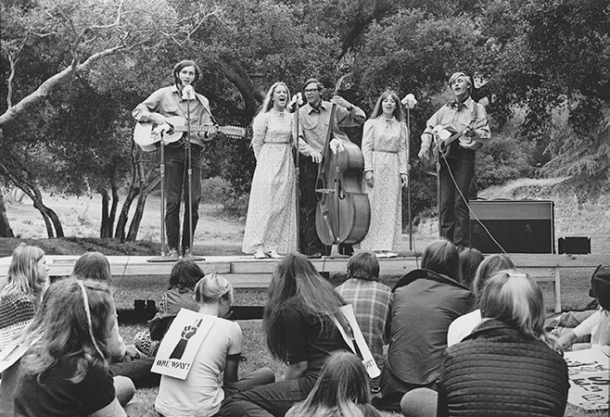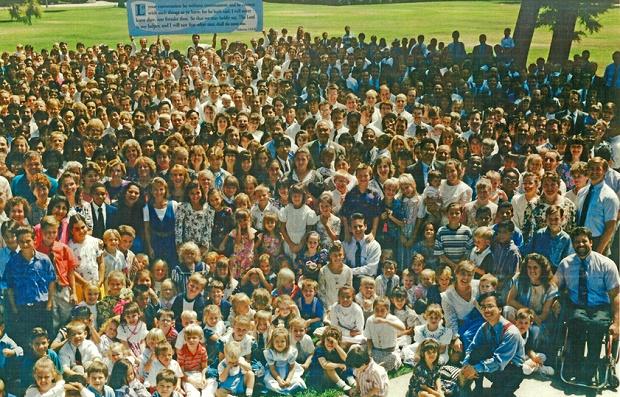Influences Behind the Assembly
Who Were George and Betty Geftakys?
George Dmitri Geftakys and Betty Olive Jessup met in the mid-1940's as students at the Bible Institute of Los Angeles and were soon married. After George graduated in 1952, he became pastor of Sunkist Baptist Church in San Fernando, CA. Differences soon arose with the elder board. George said he resigned. He and Betty began attending the Plymouth Brethren assembly in Pomona. Betty supported the family as a teacher while George took theology classes at Talbot Seminary in theology and philosophy classes at USC.
Plymouth Brethren Background
George and Betty attended Plymouth Brethren assemblies in Pomona and Fullerton. The Fullerton meeting is now called "Grace Bible Chapel".
The Plymouth Brethren are a non-denominational Bible-based group that began in England in the 1830's. In the beginning, they did not have paid clergy. They believed, as Watchman Nee taught, that all denominational churches had failed.
Originally, the Brethren met in
rented facilities, with chairs set in a semi-circle
around a table. All the men were encouraged to preach, and there were
usually two or three messages on Sunday morning. The Lord's Supper was
celebrated weekly. Women were not allowed to speak, and were required to wear head
coverings (generally a scarf or lace mantilla).
Women were not allowed to speak, and were required to wear head
coverings (generally a scarf or lace mantilla).
The original Plymouth Brethren have since split into many factions. Many of them have become more like evangelical churches, but some still adhere to original Brethren distinctives. The Geftakys Assemblies most resembled the branch known as the Exclusive Brethren, but had no ties with them.
For more about the Brethren: Wikipedia: The Plymouth Brethren; and Plymouth Brethren Heritage on this site.
George's Problems with the Local Brethren Assemblies
By the time George and Betty had been with the Brethren for about fifteen years, problems had developed. George was unhappy with the Brethren leadership because they would not allow him become an elder.
They were unhappy with him because he was too domineering. There was also an allegation of adultery against him by a neighbor, which she brought to the elders at the chapel. Her complaint could not be proven, but the leaders insisted that George get a job and support his family.
George was highly offended, and George and Betty stopped attending church completely for about two years. By the late 1960's George had a job selling insurance, and he and Betty had returned to the Brethren.
The Brethren allowed George to be a visiting preacher to the various Brethren assemblies in Southern California, but would not give him a place of leadership. He was critical of the Brethren, asserting they had "lost the vision" and become worldly.
History and Development of the Assemblies

In 1969, as the
Jesus Movement
was gaining momentum, the Geftakys' met several young couples who were
looking for something more authentic than the denominational churches,
something more spiritual and more serious. They invited George to visit
their weekly home Bible study in the San Fernando Valley, CA, and soon he
became the teacher. At the same time, the Geftakys' younger son,
Timothy, was a high school student whose friends also wanted a Bible study.
In response George began a Saturday morning Bible study in his home in
Fullerton.
 During this period, the Geftakys'
met the widow of C. J. B.
Harrison, pastor and missionary from the T. Austin-Sparks movement in
England which had connections with Watchman Nee and the "Higher Life"
teaching of the early Keswick conferences. Mrs. Harrison introduced George
and Betty to many Sparks-affiliated groups across the United States and
Europe.
During this period, the Geftakys'
met the widow of C. J. B.
Harrison, pastor and missionary from the T. Austin-Sparks movement in
England which had connections with Watchman Nee and the "Higher Life"
teaching of the early Keswick conferences. Mrs. Harrison introduced George
and Betty to many Sparks-affiliated groups across the United States and
Europe.
The role of George's introduction to Sparks’ ministry in the development
of the Assemblies was crucial. Without it, his sphere of ministry would
have remained limited to the Plymouth Brethren and young people in
Southern California.
George was invited back to speak in many of these groups, both in the USA and Europe. He was able to take over the leadership of several Sparks-related groups in the USA for awhile. These groups, along with the Bible studies he was leading, formed the nucleus for his ministry. By 1972, George had quit his insurance job and had begun several small Assemblies--Fullerton, CA; Norfolk, NE; Tuscola, IL--all separate from the Plymouth Brethren and Sparks, but along the same lines.
George was also regularly visiting Sparks' groups in France, Austria,
Germany, Spain, the Netherlands and Kenya. He conducted four weekend seminars a
year in Fullerton that were attended by 300-400 people from across the
USA and Europe. His aim was  not high numbers, but devoted loyalty from a
solid core of elite Christians. The movement eventually included
Assemblies scattered across the USA and of the world, including Canada,
Nigeria, Mexico, England, France, the Netherlands, China and other countries
as well.
not high numbers, but devoted loyalty from a
solid core of elite Christians. The movement eventually included
Assemblies scattered across the USA and of the world, including Canada,
Nigeria, Mexico, England, France, the Netherlands, China and other countries
as well.
For further information on the Keswick, Plymouth Brethren and Watchman Nee connection, refer to the T. Austin-Sparks website, and Identification History by Miles Stanford. Other articles on Assembly background and development are The Geftakys Assemblies - an Overview, and the in-depth History of the Geftakys Assembly Ministry and Midwest and Tuscola History.
Next: 2003 Implosion of George's Assembly ministry »
